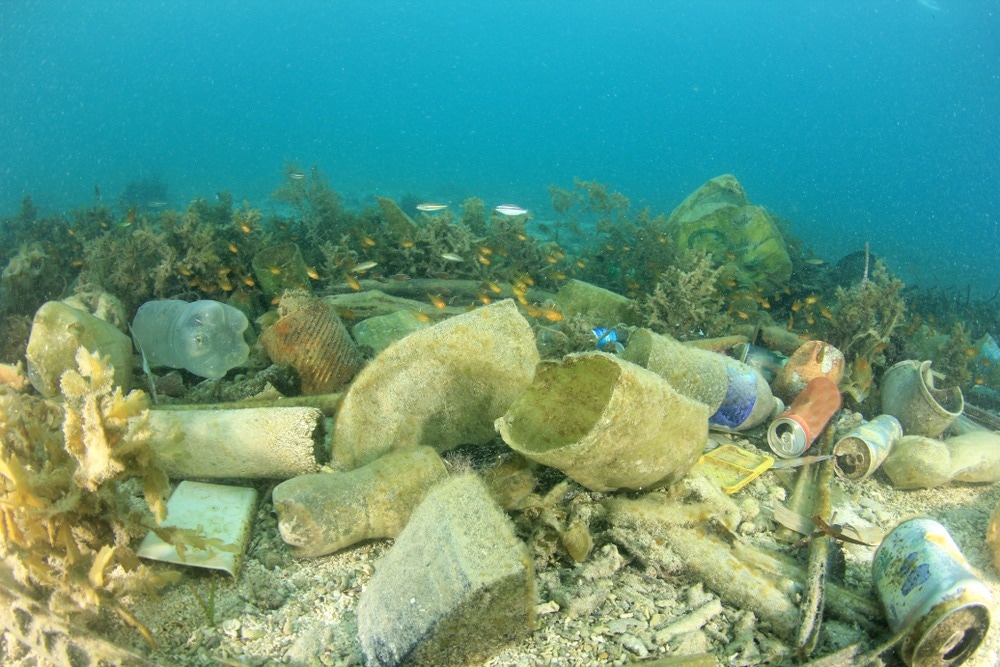A recent paper published in Nature Communications reveals that plastic leachate is more chemically different, bioavailable, and promotes more microbial growth in water than natural organic matter.

Study: Plastic Pollution Fosters More Microbial Growth in Lakes than Natural Organic Matter. Image Credit: Rich Carey/Shutterstock.com
Freshwater is heavily polluted by plastic. Plastic breakdown, both abiotic and biotic, releases carbon-based substrates for heterotrophic development. However, there is limited understanding of how these novel chemical compounds affect microbial metabolism.
This study reveals that plastic pollution may promote aquatic food webs and identifies areas where pollution reduction techniques may be most successful.
Significance of Plastic in Growth of Bacteria
Microbes' responses to widespread and increasing plastic contamination in freshwaters affect ecosystem metabolism and food web health. Plastics leach dissolved organic matter (DOM) through photochemical, mechanical, and biological deterioration, providing a foundation for biofilm colonization.
This plastic leachate may supply energy for bacterial development and can be transmitted upwards via food webs to enable higher trophic level growth. However, harmful chemicals added to synthetic polymers during manufacturing to promote plastic flexibility and heat stability may inhibit microbial growth in plastic leachate.
As many of these harmful additions are hydrophobic organic chemicals that bind securely to synthetic polymers, they can damage and biomagnify higher trophic levels that consume bacterial decomposers.
Determining the optimal circumstances for bacteria to proliferate and deplete plastic leachate from the environment might assist in prioritizing efforts to reduce and clean up global plastic pollution.
Relationship Between DOM and Bacteria
Bacteria's ability to break down plastic leachate is affected by the molecular composition of natural DOM, which varies across lakes and rivers.
The molecular composition of natural dissolved organic matter varies between lakes and rivers, influencing bacteria's ability to degrade plastic leachate.
In waters with labile DOM, leachate may not benefit bacteria because bacteria might not adapt to these substrates.
Their functional properties vary throughout space due to stochastic mechanisms, dispersal histories and environmental factors.
Investigating the Effects of Plastic Leachate on Microbial Growth in Lakes
Sheridan et al. proposed that the chemical composition of the preexisting lake's DOM influences the response of microorganisms to plastic leachate.
Surface waters from 29 lakes with varying concentrations of dissolved organic matter were incubated with and without low-density polyethylene (LDPE) plastic leachate.
The surface lake water was treated with an ecologically realistic quantity of leachate or an equivalent volume of distilled water.
The chemical composition of natural occurring DOM was compared to plastic leachate using Fourier-transform mass spectrometry.
The bacterium protein production (BPP) was determined by biomass uptake and growth efficiency (BGE).
Significant Findings of the Study
Plastic-derived DOM differed significantly from natural DOM in stimulating bacterial growth. Plastic leachate had more than doubled bacterial biomass production compared to the control treatment.
The molecular formulae of DOM from plastic leachate were less diverse. However, plastic leachate showed a greater lability index and included 35% unique molecular formulae.
Despite providing minimal carbon to the lake's DOM, plastic leachate boosted the BGE and BPP of natural bacterial populations after three days. Adding plastic leachate raised mean BPP by 2.29 times and BGE by 1.72 times.
Bacterial growth was more efficient in the presence of plastic leachate than when only natural lake DOM was available. The addition of plastic leachate increased BGE by 1.72 times compared to the control treatment.
The impact of plastic leachate on BGE varied with the variety of bacteria present in the lake. High amounts of plastic leachate can inhibit microbial growth because they include many harmful chemicals.
Plastic pollution can stimulate marine food webs and indicate locations where pollution mitigation techniques may be most effective.
Limitations of the Study
The research only examined bacteria. However, other microorganisms, such as fungus and microalgae, are similarly impacted by plastics and plastic leachates. These new interactions may affect how ecosystems respond to plastic waste.
The experiment only leached LDPE. The chemical composition of leachate from various plastics will undoubtedly vary. Therefore, the type of plastic in lakes may also affect microorganisms and the surrounding ecosystem differently.
The research employed a single LDPE concentration to represent plastic concentrations in lakes. Higher concentrations may have less beneficial effects on microorganisms due to harmful chemicals.
The Future of Plastic Pollution in Lakes
Plastics will continue to harm the ecosystem for a long time. Therefore, the results of this study are valuable as they indicate the lakes that would benefit most from plastic pollution control by removing dissolved plastic leachate.
Reference
Sheridan, E.A., Fonvielle, J.A., Cottingham, S., Zhang, Y., Dittmar, T., Aldridge, D.C., & Tanentzap, A.J. (2022). Plastic Pollution Fosters More Microbial Growth in Lakes than Natural Organic Matter. Nature Communications. 13, 4175. https://www.nature.com/articles/s41467-022-31691-9
Disclaimer: The views expressed here are those of the author expressed in their private capacity and do not necessarily represent the views of AZoM.com Limited T/A AZoNetwork the owner and operator of this website. This disclaimer forms part of the Terms and conditions of use of this website.